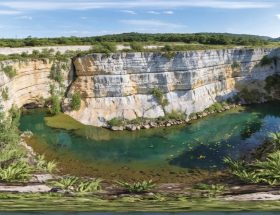Bluestone’s remarkable thermal properties have revolutionized modern architectural design, offering both aesthetic appeal and practical temperature regulation benefits. This ancient metamorphic rock naturally absorbs, stores, and gradually releases heat, making it an exceptional choice for both indoor and outdoor applications. When exposed to sunlight, bluestone’s dense crystalline structure captures thermal energy, maintaining comfortable surface temperatures even as ambient conditions fluctuate. This inherent characteristic has made it a preferred material for pool decking, patios, and interior flooring in climate-conscious design.
Professional architects and designers increasingly specify thermal bluestone for its dual benefits of sustainability and comfort. The material’s natural ability to resist extreme temperature swings reduces the need for artificial heating and cooling, contributing to energy efficiency in residential and commercial spaces. From contemporary urban developments to historic preservation projects, bluestone’s thermal mass properties continue to prove invaluable in creating comfortable, energy-efficient environments that stand the test of time.
Understanding Blue Stone’s Thermal Properties
Heat Absorption and Retention
Bluestone demonstrates remarkable heat absorption and retention properties, making it an excellent choice for thermal applications. When compared to other natural stones like granite or limestone, bluestone exhibits superior thermal mass characteristics due to its dense molecular structure and dark coloration. This allows it to effectively absorb heat during the day and gradually release it as temperatures drop.
The stone’s thermal conductivity rating typically ranges between 1.0 and 2.0 W/(m·K), positioning it favorably among natural building materials. During summer, bluestone can absorb significant solar radiation, while in winter, it efficiently stores heat from direct sunlight or artificial heating systems. This characteristic makes it particularly valuable for outdoor living spaces and thermal mass applications in sustainable building design.
What sets bluestone apart is its balanced heat retention cycle. Unlike lighter-colored stones that may reflect more heat, or darker stones that can become uncomfortably hot, bluestone maintains a moderate temperature profile. This property makes it ideal for pool coping, patios, and walkways where comfort and safety are paramount considerations.
The stone’s thermal performance is further enhanced when properly sealed and maintained, ensuring optimal heat absorption and distribution throughout its service life.

Thermal Mass Properties
Bluestone’s remarkable thermal mass properties make it an excellent choice for temperature regulation in both interior and exterior applications. This dense natural stone effectively absorbs, stores, and gradually releases heat, helping to maintain consistent temperatures throughout the day. During summer months, bluestone absorbs excess heat, keeping indoor spaces cooler, while in winter, it retains warmth from the sun or indoor heating systems, releasing it slowly to help reduce energy costs.
The stone’s high density, typically ranging from 2.5 to 2.8 g/cm³, contributes to its superior heat retention capabilities. This natural temperature regulation effect is particularly beneficial in spaces with direct sunlight exposure, such as patios, pool decks, and sunrooms. When properly incorporated into building design, bluestone’s thermal mass can reduce temperature fluctuations by up to 6-8 degrees Fahrenheit, leading to more comfortable living spaces and potentially lower energy bills.
These thermal characteristics make bluestone an increasingly popular choice for sustainable architecture and energy-efficient design, especially in climates with significant temperature variations between day and night.

Practical Applications in Architecture
Pool Decking and Patios
Bluestone thermal pavers excel in pool decking and patio applications, offering a perfect balance of aesthetics and functionality. As a heat-resistant natural stone, bluestone maintains a comfortable surface temperature even during peak sun exposure, making it ideal for barefoot areas around pools and outdoor living spaces.
The stone’s thermal properties help regulate surface temperatures in two ways. First, its natural density allows it to absorb heat gradually rather than becoming instantly hot like many artificial materials. Second, the textured thermal finish creates microscopic air pockets that help dissipate heat more effectively than smooth-finished stones.
Pool owners particularly appreciate bluestone’s non-slip characteristics when thermally finished, providing essential safety for wet areas. The material’s natural cooling properties ensure that children can play safely on the surface without risk of burns, even during hot summer days.
In patio applications, thermal bluestone creates comfortable gathering spaces that remain usable throughout the day. The stone’s ability to maintain moderate temperatures extends the practical hours of outdoor enjoyment, especially in regions with intense sun exposure. Additionally, its natural appearance ages gracefully, developing a subtle patina that enhances its character over time while maintaining its thermal benefits.

Indoor Flooring Solutions
Bluestone’s remarkable thermal mass properties make it an exceptional choice for indoor flooring applications. When properly installed, these dense natural stone tiles actively contribute to a building’s temperature regulation benefits, helping maintain consistent indoor comfort throughout the year.
During winter months, bluestone flooring absorbs heat from direct sunlight or indoor heating systems, gradually releasing this warmth back into the space as temperatures drop. This natural heat retention helps reduce heating costs and eliminates cold spots commonly associated with other flooring materials. In summer, the stone’s cooling properties work in reverse, absorbing excess heat from the air and helping maintain a pleasantly cool indoor environment.
The effectiveness of bluestone’s thermal properties is particularly notable in spaces with proper sun exposure through windows or skylights. When incorporated into a passive solar design strategy, these floors can significantly reduce HVAC energy consumption while providing year-round comfort. The stone’s thermal performance is enhanced when installed over a concrete substrate, creating a comprehensive thermal mass system.
For optimal results, designers often recommend slightly thicker bluestone tiles (approximately 20-30mm) for indoor applications where thermal benefits are a priority. This thickness provides ideal thermal mass while maintaining practical installation requirements.
Maintenance and Long-term Performance
Surface Treatment Effects
The surface treatment applied to bluestone significantly impacts its thermal performance and overall functionality. Honed finishes tend to reduce heat absorption compared to natural-cleft surfaces, making them slightly cooler to touch in direct sunlight. Thermal finishing, which involves flame-treating the stone’s surface, creates a textured appearance while enhancing slip resistance and maintaining moderate heat retention properties.
Sealers play a crucial role in managing thermal characteristics. Penetrating sealers allow the stone to breathe while providing protection, helping maintain its natural thermal properties. In contrast, topical sealers can slightly increase heat retention, though this effect is minimal. Water-based sealers generally have less impact on thermal properties than solvent-based alternatives.
For optimal thermal performance, many professionals recommend maintaining a natural or honed finish with a high-quality penetrating sealer. This combination preserves the stone’s inherent ability to regulate temperature while ensuring durability and ease of maintenance. Regular resealing is essential to maintain these properties, particularly in high-traffic areas or regions with extreme temperature fluctuations.
Weather Impact and Durability
Bluestone demonstrates remarkable resilience against various weather conditions while maintaining its thermal properties. During summer months, the stone’s natural cooling characteristics help regulate surface temperatures, making it ideal for outdoor spaces like patios and pool decks. In winter, bluestone retains heat effectively when exposed to sunlight, contributing to more comfortable outdoor areas during cooler periods.
However, extreme weather conditions can impact the stone’s thermal performance. Prolonged exposure to freezing temperatures may lead to slight surface expansion, while intense heat can cause minimal thermal stress. These natural responses rarely affect the stone’s structural integrity due to its dense composition and low porosity.
Moisture exposure through rain or snow can temporarily affect the stone’s thermal conductivity, but proper sealing and maintenance help preserve its thermal properties. Regular resealing every 3-5 years ensures optimal performance and protects against weather-related wear. The stone’s natural resistance to UV radiation also helps maintain its thermal characteristics over time, making it a durable choice for both indoor and outdoor applications where temperature regulation is crucial.
Design Considerations and Best Practices
When implementing bluestone in thermal applications, several key design considerations can significantly impact performance and longevity. First, proper thickness selection is crucial – generally, 30mm to 40mm thickness provides optimal thermal mass for most residential and commercial applications. This ensures adequate heat retention while maintaining practical installation requirements.
Spacing between pavers should account for thermal expansion, typically 3-5mm, filled with appropriate jointing material that can withstand temperature fluctuations. For outdoor installations, a slight gradient (1-2%) helps manage water runoff while maintaining thermal efficiency.
Professional installers recommend using a complete bedding system, including a compacted sub-base, bedding sand, and appropriate moisture barrier where necessary. This layered approach maximizes thermal conductivity while protecting against ground moisture that could compromise performance.
For interior applications, coordination with heating systems is essential. Bluestone pairs exceptionally well with underfloor heating, but proper insulation beneath the system prevents heat loss to the subfloor. The stone’s surface should be sealed with a penetrating sealer that doesn’t impede its natural thermal properties.
Climate considerations play a vital role in installation timing and methods. In regions with extreme temperature variations, installation during moderate weather conditions helps prevent thermal shock and ensures proper curing of setting materials.
To optimize thermal benefits, consider:
– Strategic placement in relation to sun exposure
– Integration with existing heating and cooling systems
– Proper ventilation in enclosed spaces
– Regular maintenance to preserve thermal properties
– Color selection, as darker blues typically absorb more heat
These considerations help ensure your bluestone installation delivers maximum thermal efficiency while maintaining its aesthetic appeal and structural integrity.
Bluestone thermal finish offers a versatile and practical solution for both residential and commercial applications. Its superior slip resistance, enhanced durability, and aesthetic appeal make it an excellent choice for outdoor spaces, particularly in areas with high foot traffic or moisture exposure. The thermal treatment process creates a textured surface that maintains the stone’s natural beauty while improving its functional properties. When properly installed and maintained, thermally finished bluestone can provide decades of reliable service. For optimal results, consider factors such as climate conditions, intended use, and regular maintenance requirements when incorporating this material into your project. Whether used for pool surrounds, patios, or walkways, bluestone thermal finish continues to be a trusted choice among designers and property owners seeking both beauty and functionality in their hardscape elements.










